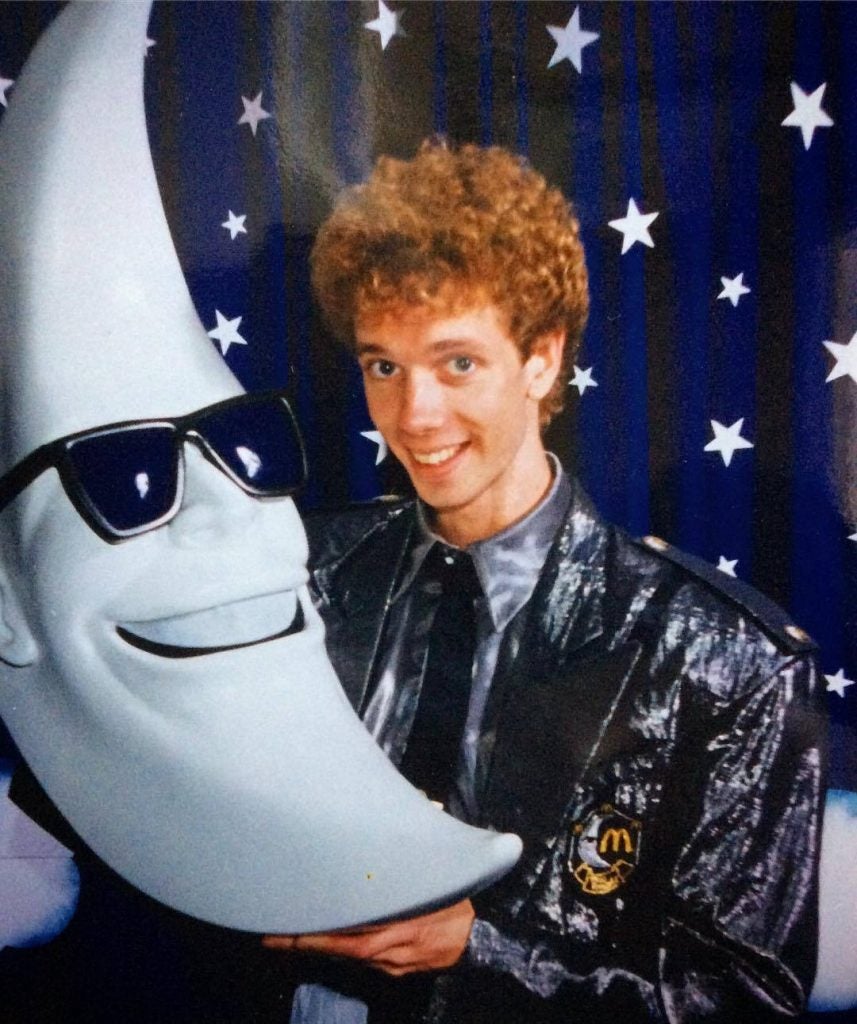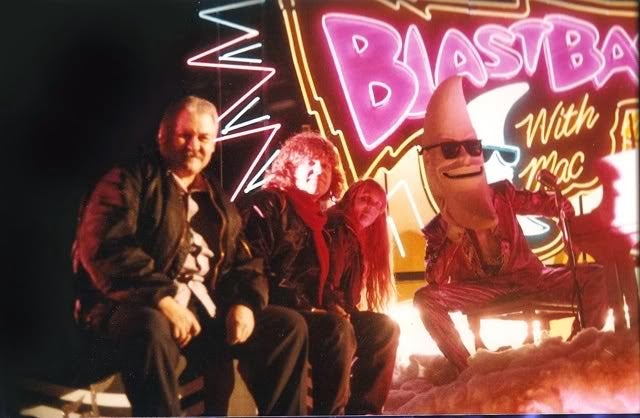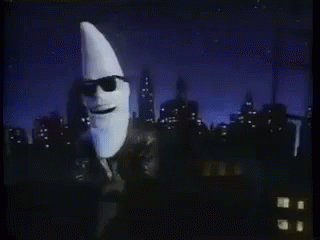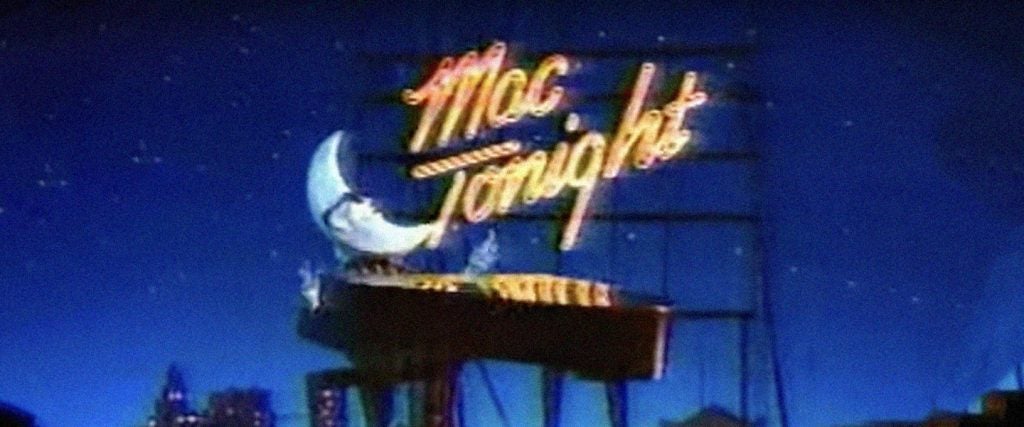The commercial began with a familiar tune. It was the swinging melody of “Mack the Knife,” which had been made famous by Bobby Darin back in 1959. Originally from the 1928 play The Threepenny Opera, the song chronicled the crimes of a serial killer, but when it appeared during commercial breaks beginning in 1986, gone were references to blood and murder. Instead, the song encouraged you to get “DINNER!” at your local McDonald’s.
The rewrite was hardly the most startling thing about the ad, though. Atop a giant spinning hamburger sat a black grand piano, and playing the instrument was a strange, somewhat eerie-looking creature with the body of a man and a giant crescent moon for a head. His name was “Mac Tonight.” Mac sang with the voice of a hip crooner, and he plonked that piano with zest, swinging his arms about whenever the music — and, presumably, the taste of McDonald’s — compelled him to do so.
Mac was something completely different for McDonald’s. Unlike the wholesomeness of prior taglines like “Nobody Makes Your Day Like McDonald’s Can,” or the kid-friendly sweetness of characters like Ronald McDonald and the Hamburglar, he was cool. Everything about him said “style” — from his music to his slick suit to his pitch-black sunglasses, which he even wore at night.
Originally the brainchild of the advertising firm Davis, Johnson, Mogul & Colombatto, Mac Tonight only played for the regional McDonald’s restaurants in Southern California at first, but they became so popular that McDonald’s corporate turned them into national spots. With a total of 27 commercials spanning four years, Mac Tonight climbed the heights of fame, not only resulting in a major increase in McDonald’s dinner business, but also spawning a variety of merchandise, including, of course, Happy Meal toys.
It wasn’t all sunshine for the moon-headed man, however, as the campaign would eventually face a lawsuit from the estate of Bobby Darin. Worst of all, decades after its retirement, the character would be perverted into an alt-right symbol of hate akin to Pepe the Frog. But again, it all started with Davis, Johnson, Mogul & Colombatto and creative director Brad Ball, who believed that “Mack the Knife” was just too perfect for McDonald’s to pass up.
Creating Mac Tonight
Brad A. Ball, former President of Davis, Johnson, Mogul & Colombatto: Since the beginning, McDonald’s advertising has been set up with both national and regional advertising agencies. In the 1980s, I’d say there was a vast network of about 60 regional agencies. You can think of them almost like National Guard units — McDonald’s would use them to help keep franchises community-oriented and to defend against different competitors in different regions.
For Southern California, the agency was Davis, Johnson, Mogul & Colombatto or DJMC, and we were the guys to introduce McDonald’s breakfast to the marketplace in 1971. We also did the very first McDonald’s game promotion, which would later go national with things like the Monopoly game. I started with DJMC right out of college in 1972, and I was on McDonald’s business within the first year.
Starting around the mid-1980s, I’d done a lot of work with McDonald’s, and I had this idea that “Mack the Knife” sounded a lot like “Mac Tonight.” I thought that would make for a great commercial for McDonald’s, especially since its biggest Achilles heel — even today — is their dinner business.
The lead creative guys on this were Pete Coutroulis and the late Jim Benedict. I worked very closely with them to develop the idea — it was one of those ideas that just got better with collaboration. We got the rights for the song from The Threepenny Opera and worked with a music company named LANY Music to develop the song. The lyrics on it came together really nicely:
When the clock strikes
Half past 6, babe
Time to head for
Golden lights
It’s a good time
For that great taste
DINNER!
At McDonald’s
It’s Mac Tonight!
Come on, make it Mac Tonight!
In particular, “It’s a good time for that great taste” was clever because that had been used in older McDonald’s advertising and was then repurposed for this.
Brock Walsh, musician and the singing voice of Mac Tonight: Mac Tonight is a fond part of my musical history. I had the good fortune of working with my friend Mark Vieha, who was one of the partners of LANY Music. We’d done a number of commercials together, and most often, I was employed as a singer. When Brad Ball had this crazy idea to do Mac Tonight, he turned to Mark, who gave me a shot. It went well. Mark and his partner, Jay Kennedy, did the arrangement, and it was such a winner. In fact, that demo we did for Brad to pitch it to Mcdonald’s was the same recording used on the first commercial.
Ball: Pete and Jim came back to me with the idea of a moon-headed guy to star in this, which made sense because it was a dinner promotion. They made “Mac Tonight” into a real character, which was the perfect way to go.
Peter Coutroulis, former Creative Director at DJMC: I know that we didn’t want a real person to sing the song. We wanted something like Max Headroom — kind of a cult character — and he had to be relatable and likable. At one point, soon after the first spots aired, we got a call from Frank Sinatra’s people saying that Frank would be interested in doing the commercials with that song. We were flattered, especially since he didn’t do commercials, but we didn’t pursue it. Mac Tonight had to be something on its own; it couldn’t be a celebrity singing the song.
Ball: We loosely pitched the idea of Mac Tonight to McDonald’s headquarters in Chicago, and once they said okay, we armed ourselves with storyboards and presented it to the franchises. I’ll never forget that because I presented it on stage, and then two of the franchisees ran up and kissed me on the cheek. They were so excited about it!
Coutroulis: It had all these great things going for it, and we were sure it was going to be a breakthrough. Of course, it was.
Making the First Commercial
Coutroulis: For the first commercial shoot, Jim [Benedict] and I plotted out the storyboards and then we hired a production company [Rhythm and Hues Studios] to produce it and a director to actually film the commercial. We were also part of the casting and hiring of people like Steve Neill.
Steve Neill, makeup and practical effects artist, founder of SNG Studio: I’ve done so many things for Hollywood — from Star Trek to Ghostbusters. With this, I was just home one day and I got a call. I then went down to be interviewed, and they showed me the concept drawings they had. I said, “That isn’t a problem. I can sculpt that up,” and I got the job.
Before this, I had just gotten through working with Doug Jones for the first time on a commercial where he played an alien. I had made a life mask of him, and I sculpted this foam rubber, full-head prosthetic with a fiberglass under-skull and eyeballs that moved and everything. He was literally glued into the alien costume for the entire day, and he was great. He was super nice and never complained. So when Mac Tonight happened, I highly recommended him to wear the costume.
Doug Jones, actor, body of Mac Tonight: When I first got the call from my agent about the audition, I was told it was for a nightclub singer. I was like 26 at the time, and I didn’t really fit that Frank Sinatra-type, but I went to the audition anyway. When I got there, there were guys like that — gray-haired Italian-looking guys in tuxedos — and I thought, “I’m never going to get this.” But then on the walls, I saw the storyboards for the commercial, and I saw this big moon head. I said to myself, “Oh, that’s why I’m here.”
They also had the song playing on a loop in the lobby so we could get familiar with it. When they brought us in, they sat us down at a keyboard and played the song, and we were encouraged to lip-sync and play along. I did it with all the vim and vigor and “I love you babe” attitude I had in me.
I remember them saying, “That was great, now let’s do that again so we can just focus on your body language.” They didn’t have the moon head made yet, so they grabbed a paper grocery bag with two eyeholes cut into it, and they slipped that over my head and said, “Let’s do that again!” I wasn’t sure if I should be humored or humiliated, but I decided to give it all the gusto I had. They loved it.
At callbacks, it was down to just a few of us. They had tall people like me in the room and short people, too — I think there was some discussion about whether they wanted a short person to make the moon head the dominant feature, or if they wanted a longer, leaner body to balance out the head. I’m 6-foot-3 and 140 pounds, so I guess they went with the latter.

Coutroulis: Doug was tall and thin, and he had been in a mime troupe. He was so animated, and Mac really had to move. He was a perfect choice.
Jones: Fortunately, when it came time for Steve to make the head, he already had a life cast of my head and shoulders from the commercial we’d done together a couple of months before. That was nice, because the fewer times I have to do that, the better.
When it was finished, that moon head was heavy! It was like 10-plus pounds on a skinny boy’s neck. I wore this helmet inside that fit me perfectly, and my eyes were lined up with Mac’s mouth. When the mouth opened, I could see, but if they had the mouth closed for a while, then my vision and air was cut off. Early on, I learned that it usually doesn’t look good until it hurts.
Inside the head was a mechanical wonder — the facial expressions were all motorized with animatronics. It took three puppeteers to control the lip movement, jaw movement and eyebrow movement. Steve was one of them, along with a guy named Bob Burns and Steve’s late wife, Gilly.

Coutroulis: If memory serves, we did the first commercial at Raleigh Studios in Hollywood. I remember being on set and being very excited. Seeing Doug up there on that big hamburger and hearing that music — it was a big thrill.
Jones: We did four spots in that first shoot, all of which had me on top of that giant rotating Big Mac. Once I climbed up there and got wired in with the animatronics, it would have been a big production to bring me back down, so I just stayed up there in that moon head, even when they were resetting cameras for an hour. I’d say, “Oh I’m fine! Don’t worry about me!” It was early in my career, and I never wanted to make a fuss, so I’d be in there for multiple hours at a time. It wasn’t unusual for me to spend up to five hours in that thing, and only break for lunch.
There were times where I was probably being too nice, though. Some time later, there was one shoot where I was up on a cloud, and someone said, “You okay up there?” and I said, “Yeah. I’m fine!” and that was all they said. Eventually, however, I tilted my head down and saw that everyone was down eating dinner, and no one told me that’s what we were breaking for! Yeah, I was probably too nice.
I still remember the choreography of that first commercial. There was a part of the song where Mac gives a big “Hey!” and during that, I threw my arms out to the side and did a big shoulder shrug. I was just having fun with it, but I remember the director getting very specific on that and trying to hone it to a more iconic place. I did it over and over, and it ended up where I did a shoulder shrug with a bending of the elbows and my hands went out sideways with splayed fingers. It seemed like a bit much, but when I saw the commercial I got it. That became Mac’s signature move, and it ended up in pretty much every commercial.

Coutroulis: The shoot went really well. It was a happy kind of commercial, and to me, that’s still the best spot we did. The funny thing about that commercial is that there was no real burger in it. We had the giant burger he sat on, of course, but there were no fries, no Big Mac, no appetite appeal; it was just the song and Mac.
Jones: I remember finding out it was going to start airing in December of 1986. At the time, I had a 13-inch black-and-white TV in my small apartment in the Valley. My wife Laurie and I made some frozen burritos, and we sat in front of that little TV. I remember screaming, “There it is!” when it came on.
Walsh: It had good music and good visuals. You can’t argue with what works, and these ads definitely worked.
Coutroulis: When Mac Tonight broke, all of a sudden the dinner business in the region went up like 10 percent overnight. It was huge, which, of course, caused the national McDonald’s in Chicago to take notice.
Mac Tonight Goes National, Then Global
Coutroulis: This was like a longshot going to the Super Bowl. It was a big deal for us.
Ball: For everyone, but the agency especially, there was a great deal of pride in the success of Mac Tonight — it raised our profile.
Jones: I believe DJMC did the first batch of national ads, and then there was a handoff to Leo Burnett, who did the national advertising for McDonald’s. It was a new advertising company, but they still kept me, Steve, Brock and a guy named Roger Behr, who was the speaking voice of Mac Tonight.
I remember in that first batch of national ads, we did one spot in a carnival, and another in front of a Big Ben-type clock. Around this time, DJMC took out a full page ad for Mac Tonight in Ad Age magazine. Nobody knew it was me, but I was like, “I’m in a full-page ad in Ad Age!” I was so full of myself that day.
During the height of it all, I remember thinking that no one knows it’s me under the mask. I wanted everyone to know, so I wore this black satin crew jacket with the Mac Tonight logo on it all the time. I’d wear it in public in the hopes that someone might notice it and ask me questions. That never happened, though — no one asked.
Ball: We did the first series of commercials, which were local, then those ran nationally. After that, we got out of the Mac Tonight business because the bigger company could write the bigger checks.
Coutroulis: To me, it was never quite the same when the national agency took it over. I just don’t think they were as interesting or creative. I don’t know that they understood who Mac was and how to take him further.
Jones: They ended up making 27 commercials total.
Ball: Mack was everywhere, too. Some franchisees even had full-size animatronic Mac Tonights built that sat at a grand piano in the restaurant, kind of like what you’d see at Chuck E. Cheese. I think a few of those are still around. He was also on The Simpsons! You can’t get any bigger than that!
Jones: They began doing live appearances of Mac at franchise locations all over the country, and they mass-manufactured walkaround Mac Tonight heads that weren’t mechanized for people to wear. I didn’t make the appearances, but in order to train those people across the country, they flew me to Chicago to film an instructional video. It was like a 20-minute video about how they were to behave and how to remain in-character. I even had a choreographed dance number that they could do to the Mac Tonight theme song during their in-store appearances. I have that on VHS somewhere, even though I can’t play it anymore.
I still have quite a bit of Mac Tonight merchandise. I have all the Mac Tonight Happy Meal toys, which all had Mac in some mode of transportation. There was also a lot of merchandise from Spencer Gifts, which had a whole product line with sippy cups, beach towels, T-shirts and all kinds of things. I still have two beach towels.
Ball: Right now, I’m looking at my Mac Tonight clock. I remember I once found Mac Tonight trash cans for sale at my local Pick and Save — I bought all of them!
Walsh: For a three-year window, Mac Tonight was everywhere — that was my 15 minutes. I was brokenhearted when it all came to a grinding halt thanks to Bobby Darin’s kid.
The End of Mac Tonight
The Buffalo News, excerpt from “McDonald’s Sued for ‘Mac Tonight,’” October 9, 1989: The son of the late singer Bobby Darin is suing McDonald’s Corp. for more than $10 million, alleging the restaurant chain copied his father’s singing style in the “Mac Tonight” commercials. The suit, filed last week in Los Angeles County Superior Court, alleges that the television ads infringe on rights to Darin’s 1959 hit version of the song “Mack the Knife.” The suit alleges the character’s voice and gestures resemble those of Darin, who died in 1973 at age 37 of heart problems. The suit was filed on behalf of Dodd Darin — the singer’s son and only heir — and the Bobby Darin Testamentary Trust.
Coutroulis: From what I know about the lawsuit, after Mac Tonight had been running for a few years, the family of Bobby Darin felt it was an infringement on Darin’s character and what Darin did. I never quite understood it because we got the rights to the song, which was from The Threepenny Opera, but McDonald’s didn’t really seem to fight it. They just let it go.
I think, maybe, had Mac been a character like Ronald McDonald — that increased business year after year after year — McDonald’s might have fought this. But Mac was kind of dying off anyway, so they let it go.
Walsh: They thought that I had co-opted his father’s singing style, and they filed suit for infringement of likeness. Specifically, my vocalization was apparently the issue. To me though, Bobby Darin wasn’t the imprint on that song. I was more influenced by guys like Frank Sinatra, Ray Charles and Louis Armstrong — Louis Armstrong was known for this song, too.
That brought the gravy train to a grinding halt. I do think, though, that this lawsuit coincided with the downturn of Mac Tonight ads as effective marketing anyway. I think McDonald’s looked at it like, “Do we really want to fuck with this? Isn’t it easier to just cut and run from the whole thing?” So that’s what they did. It’s cool, though. It’s a business. I get it.
I think they tried to change the song for a bit, but it just didn’t work. Mac was done soon after that.
Jones: They brought him back for a spot in 1996 for a regional West Coast ad, and I came back for that. I was tickled to come back and do more — it was like visiting an old friend. That was the last time for me, though. Years later, they revived him in CG in Singapore, I think, but I wasn’t part of those.
Walsh: I look back on Mac fondly, but, sadly, I recently read about how Mac Tonight was co-opted by white supremacists online, which is really sad to me.
The “Moon Man” of the Alt-Right
The Kavernacle, YouTuber covering internet culture and politics: Starting around 2006 or 2007, “Moon Man” rap parodies began appearing online featuring Mac Tonight’s image with computer-generated speech from AT&T Labs Text. Some were harmless, but some of them featured racist references and associations with the KKK. Around 2015, racist alt-right “Moon Man” memes and raps became very popular on 4chan and YouTube. There was also a mod on the video game Doom where you could play as Hitler or the Moon Man, and the enemies were all racist stereotypes of various minorities. By now, most of the YouTube videos of the racist raps have been taken down, but you can still find the Doom mods.
Much like the Nazis appropriated the Swastika, the alt-right has done the same with all sorts of imagery, often as an in-joke. Clown emojis, Pepe the Frog and the Moon Man serve the alt-right by being things they can use to spread hate, and then they can rebuke any criticism by saying “It’s just a meme.” But really, it’s a way to spread hate out in the open.
Jones: All I have to say on this subject is that this is not what Mac is about. He’s a cool cat who sings about McDonald’s. Period, the end.
Mac’s Legacy
Ball: Even today, whenever I look up and see a sliver of the moon, the first thing I think of is Mac Tonight.
Neill: There’s still a huge fan following for Mac Tonight. There are people who write to me all the time asking me if I still have the molds of the heads. I don’t. The last two heads I had I gave to Bob Burns and he put them in his museum.
Jones: Mac Tonight was a happy character that was lovable and hip. It was a unique visual paired with music that stuck with people, which made it really memorable. Plus, those commercials were run in such high rotation that there was no way to avoid them. Some love him, some were creeped out by him, but he was certainly memorable. For me, I was able to buy my first house from what I made from that campaign, and it gave me a reputation in the creature-effects world that would help shape my career going forward.
Walsh: I was the luckiest guy in the world to score that gig — color me grateful. Let me tell you though, you know the best thing about being the voice of Mac Tonight? Karaoke! When I go into a karaoke bar and put on “Mack the Knife,” I start singing, “When the clock strikes, half past six, Babe!,” and people go “Holy shit! You fucking sound like Mac Tonight!”
Yeah, that’s what my life has come to now. That’s the sad truth of my life — that my most notable gig might get me a free drink at a karaoke bar.
Coutroulis: It’s been a lot of years, but even today, I’d love to bring Mac back — that’s even the line I would use: “Mack is back!” Unfortunately, with how he’s been twisted in recent years, I don’t think that will ever happen now, which is too bad. But hey, it’s done, it’s gone. Mac Tonight had his day and it was great.

